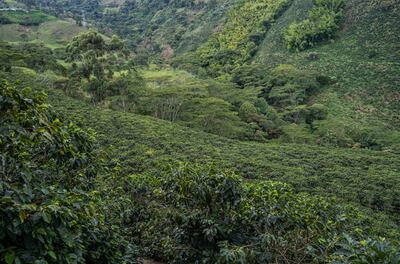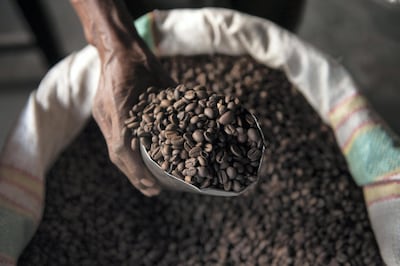Each year around 400 billion cups of coffee are consumed around the world, making the beverage the second in popularity, only to water.
Meanwhile, coffee as a crop, which is grown on around 12.5 million farms in more than 50 countries, is said to generate more revenue for developing countries than any commodity, except oil.
While the coffee industry is estimated to be worth hundreds of billions of dollars each year, cultivating the bean come at a price to the environment.
The impact ranges from forest clearances in Central America and the contamination of rivers by coffee processing plants, to the creation of hundreds of thousands of tonnes of organic waste and the generation of carbon emissions.
A key way in which coffee production generates carbon emissions is linked to nitrogen fertiliser often used with coffee trees. It has been calculated that nitrogen fertiliser production accounts for around 2 per cent of global greenhouse gas emissions.
This production is “very energy intensive” says Jeremy Haggar, professor of agroecology at the University of Greenwich’s Natural Resources Institute in the UK. “You have to fix nitrogen from the atmosphere usually. That contributes to the embedded greenhouse gas or CO2 emissions associated with the fertiliser,” adds Prof Haggar, who has spent two decades researching the coffee industry, a lot of it in Central America.

Once the fertiliser is applied, it partially turns into a potent greenhouse gas called nitrous oxide, adding to the impact on the climate.
Prof Haggar says that fertiliser use, while not especially high for coffee compared to other crops, varies significantly between farms. “There are farmers who apply none and farmers who may apply very high amounts — hundreds of kilograms per hectare,” he said. “Highly productive farms will tend to be using fairly high and large amounts.”
Certificates are provided to indicate if coffee is grown in a more sustainable way. They include certification from the Rainforest Alliance, which promotes sustainable production methods, including avoiding the excessive use of fertiliser.
Planting shade trees can protect the crop from extreme weather and reduce nutrient demand and the need to use fertiliser.
In addition to looking for certificates, consumers may wish to choose coffee that is less likely to have been grown in a vast monoculture; which is the practice of growing one crop species in a field at a time.

Such monocultures are more common with Robusta beans, according to Mark Maslin, professor of earth system science at University College London and author of How to Save Our Planet: The Facts. Arabica beans however, tend to be grown more often, he said, in smaller, better managed farms.
How the coffee is processed and transported also changes its environmental impact. Coffee is picked as cherries, which can be dried before the removal of the coffee beans. This leaves behind dry fruit material, which Prof Haggar says should ideally be used as compost. “Depending on how it’s done, this can also release methane and nitrogen dioxide,” he added, referring to two potent greenhouse gases.
The alternative “wet” processing method involves the fleshy outer pulp of the cherries being removed, which also generates methane as well as a large amount of contaminated water.
“What is most useful is if the coffee cherries are dried and processed in the country of origin. That reduces the weight that has to be shipped down to one third,” said Prof Maslin.
The way that coffee is transported is another factor affecting that plays on its environmental impact, with transport by sea generating significantly less carbon emissions than by air.
Work by Prof Maslin and his PhD student Carmen Nab, published in 2020, found that 1kg of Arabica coffee generates 15.33kg of CO2 when grown in Brazil or Vietnam and transported to the UK by air.
However, if fertiliser is used sparingly, water and energy use minimised during processing and the coffee is shipped by sea, the figure can fall to 3.51kg of CO2.
Numerous studies have compared the environmental impact of different types of coffee, including research from Canada published this year that looked at filter coffee, coffee in a capsule, cafetiere coffee and instant coffee.

Writing in an online magazine, the researchers said that traditional filter coffee “clearly” generated the largest quantity of greenhouse gases, largely because more coffee powder is consumed.
Coffee capsules came out, perhaps against expectations, as an eco-friendly option, despite the waste they generate, because when people make a drink with these capsules no more coffee than is necessary is used and only the required amount of water is heated.
Instant coffee has the lowest impact, but only if recommended quantities of coffee and water are used. When making a cup of instant coffee, it is easy to boil two or three times as much water than is needed and to have to re-boil the kettle because the hot water has been left for a while.
In this way, energy consumption can climb well above what is needed and, the authors say, instant coffee is then no longer the most energy efficient.
A 2018 study from Australia also concluded that instant coffee was the most environmentally friendly, with the caveat being again that no more water than necessary is boiled.
To the contrary, a recent study by The University of Manchester and published on ScienceDirect found that the climate change impact of instant coffee, measured in terms of CO2 emissions generated, was about five times that of ground coffee.

“The main reasons for a five-times higher impact of instant coffee are its glass packaging and the higher energy requirements in the coffee production process,” the authors wrote in Chemical Engineering Journal.
The packaging of instant coffee, mostly a polypropylene lid and a glass jar, accounts for around half of the climate change impact, the authors found.
“The results suggest that ground coffee is environmentally and economically more sustainable than instant coffee … because it requires less green coffee beans and energy to produce the same amount of product,” the authors added.
In line with other studies, they found that darker roasts had a higher environmental impact than lighter roasts because the former require higher roasting temperatures.

What coffee enthusiasts consume along with the coffee itself also has a big effect on the carbon footprint, with Prof Maslin’s research finding that adding milk in particular was significant.
“You triple it because you’re making a cappuccino,” he said.
Conclusions depend on how the carbon emissions are being measured. A study from 2014 cited by Prof Maslin found that a latte generated 224g of CO2 emissions per serving, compared to 49g for an espresso.
If the impact is, however, measured per millilitre instead of per serving, the latte has a lower carbon footprint than espresso.
Another factor is what cups the coffee is drunk in, with a reusable mug typically preferable in terms of its low environmental impact.
Dr Jeroen Guinee, an associate professor at Leiden University in the Netherlands, says that partly depends on consumers' behaviour.
“If we wash our reusable mug elaborately every day with hot water and soap, and break it or otherwise shorten its lifetime, the difference between a mug and disposable plastic or paper cups may not be that big,” he said.

“Normally, however, the reusable mug will clearly environmentally outperform the disposable paper and other alternatives.”
Prof Haggar said that, in keeping with greater awareness about environmental issues more widely, sustainability has become more of an issue in the coffee industry in the past two decades.
“That’s led to substantial investments by coffee traders and buyers, and by coffee farmers, in reducing the environmental impact,” he said.
Nonetheless, he said that probably around two-thirds of coffee production still “has a way to go” in achieving a good environmental performance.





